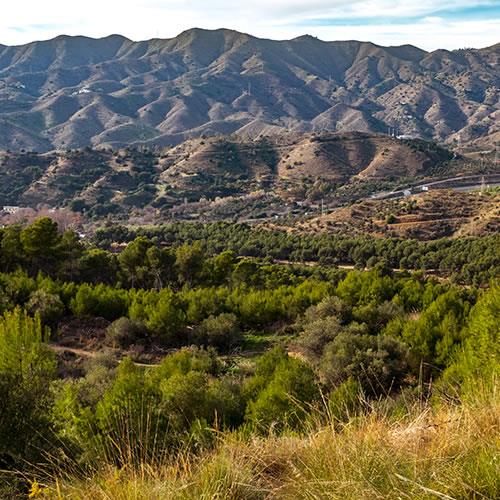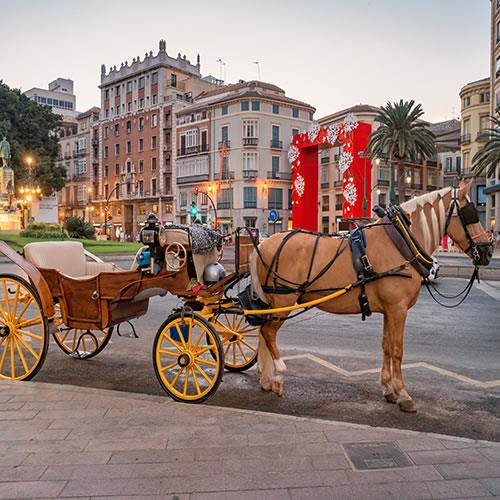Day 1 in Málaga
Welcome to the Costa del Sol! Upon arrival, you will go through customs and immigration. Should you opt to purchase a transfer to your hotel; a representative will be waiting for you as you exit immigration. Make your way to Málaga and arrive at your hotel. Check in and do not give in to jet lag! There is so much for you to see and do!
Spend what you have left of the first day getting acquainted with the city by visiting one of the hubs of social life in Málaga, the Plaza de la Merced, located at the edge of the historic center of town. At the Plaza, you will be able to people-watch, enjoy a snack at a café or street vendor, and see the building where Pablo Picasso, the noted artist, was born.
The building, the Fundación Picasso Museo Casa Natal, has been transformed into a museum dedicated to his life and his life`s works. If you want to see more works of art from this talented visionary, the Museo Picasso Málaga is slightly larger and is about 650 feet to the south.
If you are walking there, you will pass the Iglesia de Santiago Apóstol. Opened in 1490 inside a former mosque, it is one of the four oldest Catholic churches currently serving parishioners in Andalusia. You will need to get ready for an early morning and a busy day tomorrow, so take it easy for the rest of the day and return to your accommodations in the evening.


Day 2 in Málaga
Start early by walking up Mount Gibralfaro, which rises 430 feet above the city of Málaga. The first fortifications built on Mount Gibralfaro were constructed by the Phoenicians in the eighth century before the Common Era. The majestic Castillo de Gibralfaro we see today was completed by the 14th century by King Yusuf I of Granada. It is also well-known for being the site of a successful three-month siege by Ferdinand and Isabella in 1487, and was the fated last stand for the Muslim rulers of the city.
Afterwards, head down to the Alcazaba, considered the signature fortification of the Taifa era of the Caliphate of Córdoba, and the best-preserved example of a Moorish alcazaba to be found in Spain. Right next to the Alcazaba you will see the Roman Theatre of Malaca, dating from the first century before the Common Era. Long considered lost, it was found during archaeological excavations in the 1950s and has since been almost completely unearthed.
To the south of the Alcazaba and the Roman theatre, you will first come across a large building which was once the former customs house at the Port of Málaga. This building now houses the collections of the the largest museum in Andalusia, the Museo de Málaga, which features archaeological finds and works of fine art. Afterwards, head east, walking on the road just under the Alcazaba. You will encounter the Universidad de Málaga and Málaga City Hall, as well as the latter`s own gardens, the Jardines de Pedro Luis Alonso. Head south and then head west along the Paseo del Parque, making sure you stop to walk a trail or two at the Parque de Málaga, one of the most beautiful green spaces in town.
From there, walk up Calle Molina Lario to get to the city`s major basilica, the Catedral de la Encarnación de Málaga, perhaps better known to English speakers as Málaga Cathedral. Built in the Renaissance style and completed in the 18th century, it is the second-largest cathedral in Andalusia, second only to Seville Cathedral. Head west and within 500 feet you should reach the most popular pedestrianized shopping street in Málaga, the luxurious Calle Marqués de Larios. Window-shop along the storefronts and head north until you reach the street`s terminus at the Plaza de la Constitución. Stop for something to eat either at the Plaza or head south back down Calle Larios to the Alameda Principal. Return to your accommodations at the end of the evening.



Day 3 in Málaga
Start the morning either with breakfast at the local farmers` market, the Mercado Central de Atarazanas, or breakfast at one of the cafés or restaurants at the ultra-chic shopping and cultural center Muelle Uno, located near the Málaga cruise port in La Malagueta. The Mercado Central is built from steel produced at the same foundry which provided steel for the Triana Bridge in Seville, and one of the old marble `doors` to the old shipyard has been repurposed as the market`s entryway. Muelle Uno is a new shopping center which is hip, trendy, chic, and attracts the younger and flashier crowd in Málaga. It is also the site of one of the most popular new museums in Málaga, the Centre Pompidou Málaga.
Afterwards, enjoy a couple of hours in the sun at the signature beach in town, Playa de La Malagueta. There are bars and restaurants just off the sand if you want to enjoy a beverage or a snack while you`re there, and of course the beach offers all kinds of equipment rentals, from umbrellas to jet skis. If you want to visit the beaches further east, buses travel to as far east as the Playas del Palo. Playa de la Caleta and then Playa de Pedregalejo are two stretches of beach between La Malagueta and El Palo, for reference. If you want a beach that is a little less-traveled, but still attracts many young people, visit Playa de la Misericordia on the western side of the Guadalmedina River, past Málaga-María Zambrano train station, but before Málaga-Costa del Sol Airport. (If you have noticed that the Guadalmedina River is dry during your visit, that is actually normal; the Guadalmedina dries up for the majority of each year.)
If you have time left over, consider a trip up to La Concepción Historical-Botanical Gardens, consisting of 57 acres of plants, trees, fountains and beautiful structures built and cared for by the original owners, the Marquis and Marquess of Loring, and now by the City of Málaga. If you don`t want to travel very far, stop by the Plaza de Toros de La Malagueta to take a tour of this historic bullring. If you`re in town during Holy Week (Semana Santa) or the Féria de Agosto, buy a ticket and attend a bullfight!
In the evening, have dinner at one of the highly-recommended restaurants at La Malagueta or Muelle Uno, and return to your accommodations at the end of the night.



Additional Days in Málaga
You may have noticed mountains off to the north, and of course Mount Gibralfaro right near the city itself. Those are all part of the Montes de Málaga, a mountain range to the north of Málaga City. North of town there is a natural park, administered by the Andalusian government, that is spread out across 19 square miles. In the park, there are great hiking opportunities up the mountains and down into the Guadalmedina River Valley. It is heavily forested by pine, oak, mastic, and Irish strawberry trees. Protected animal species include the Iberian ribbed newt and the Andalusian wall lizard.
If you have the time, take a day to stop in Marbella, a perennial favorite for British expatriates. Before you enter town, you will encounter a large port and shopping area called Puerto Banus, which is considered a top luxury shopping and nightlife destination. Marbella has great restaurants, bars and cafes, many of which can be found near the ferry port. The city is quite historic, with portions of beautiful Moorish defensive walls dating back over 1,000 years rising over the Old Town.
Further down the coast, Estepona is a perfect example of a beautifully-preserved Andalusian town, even with increasing crowds of tourists who discovered what we at TripMasters have known all along, that this destination is absolutely picture-perfect. Sandwiched in between the Mediterranean Sea to the south and the Sierra Bermeja mountain range to the north, Estepona is known as the `Garden of the Costa del Sol`, due to its colorful flowerpots which hang from the sides of houses in the historic quarter.


Your Last Day in Málaga
Depart your hotel and head to the airport for your return home. We recommend that you purchase a private transfer; if so, a representative will meet you at the hotel in time to take you to the airport for your flight out. We hope you enjoyed the sights of Málaga and the beautiful Costa del Sol!
